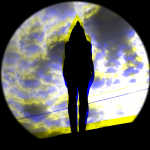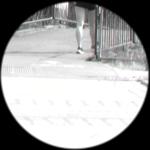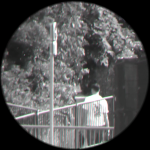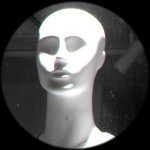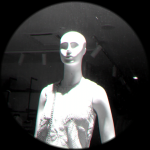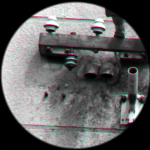Project title: REVERBERATIONS | ECHOES (subtitle: RESONANT SPACE)
Genre: video&sound interactive installation /for 4 video projectors and 6 sound bodies/
Co-production: Pixxelpoint (https://www.pixxelpoint.org/) and Cirkulacija 2 (https://www.cirkulacija2.org/)
Venue: GONG gallery Nova Gorica (https://galerijagong.si/)
Exhibition opening on friday, 21st November 2025 at 19.00. Exhibition open until 13th December 2025.
Get FANZINE REVERBERATIONS (english only)
Reverberations | Echoes is a space of memories, nostalgias, delusions, regrets, … – emotionally charged categories that usually an individual’s imagination suggests as vague visual glimpses/ fragments.
The architectural starting point is a space that is “wrapped” in video projections, and within the space there is a sound field that transitions between different forms of harmony/ disharmony. The played videos drive the dynamics of the generated sounds, which take on the nature of subtle sound resonances. An additional source of dynamics is a sensor that detects movement in the space and participates in sound changes. Four-channel video projection and six-channel sound.
The video installations displayed in the exhibition are composed through the manipulation of fragments of Francisco Tomsich’s video diaries. The practice of making video diaries are traditionally related to the concepts of immediacy, exemplarity of experience and a documentary approach to the realm of what is represented. Showing video diaries, on the other side, is a practice which has been both praised and criticized with accuracy (the discussion sometimes reflecting old topics regarding the publication of written diaries as well). In Tomsich’s case, edition and composition provides a certain number of hermeneutic layers and references to the models and genealogies he wants to address (specific traditions of experimental documentary film, video art and early film, for instance) which are visually articulated frame-by-frame. One of these elements is the circular, peep-hole-like shape of the clips which are characteristic of all his films from 2016 onward. This element shapes the visual aspect of the works, but also (since it is an aesthetic decision made prior to the actual action of recording) the relationship between the eye and the represented fragment of perception mediated by a certain technology: the “circle” works as a filter in the artist’s eye while producing the original footage, as much as the black and white “translation” of the digital colors. It functions as an internal disposition which can be correlated to the on-camera edition practices of many video artists in the first years after the advent of portable video technology.
These formal, technical and methodological aspects are determined by, and determine, the visual information displayed on Tomsich’s films. There is not abstraction in the traditional, pictorial or digital, sense of the world, and there are discourses of different kinds. The most evident is the one arising from the correlations and contradictions between the chronos of the original footage, the kairos proposed by the edition, the chronos of the displayed pieces and the many possible chronos and kairos of the viewer’s experience, specially in the framework of the preferred format of exhibition, which creates dialogues between large-format light objects which collide, disappear for a while, dis-adjust and repeat (or look like repeating). There is another kind of discourse (the one which we usually found analyzed in most of books devoted to experimental film histories and practices) in his approach to montage, which clearly aligns with the self-conscious (Vertov, Deren, Mekas, Epstein, to name a few classics) “poetic” tradition of filmmaking, as opposed to the narrative way of understanding film which won the battle for mainstreaming. This aspect has much to do with the dialectical resolution of many works (two or three clips -circles- in dialogue) or the musical metaphors used as scripts for composing the final succession of segments of the works (which can be perceived in order by the viewer or not).
One of the many elements explored in the complex associative work of Borut Savski and Francisco Tomsich has exploded this musical metaphorology of montage of individual pieces (Summer Songs), a certain evoked character of a group of works (Elegy) or the fragments of sounds and images visiting us the day After the Party. Finally, there are discourses arising from the ideologically-shaped territories of meaning the films deal with at the level of representation. The case of Reverberations | Echoes is exemplary, since all video works displayed in the exhibition deal in different ways with the critique or urban space, the persistence of modern (authoritarian) ways of understanding it, and the absurdities arising from the disconnection between plans and behaviors.
Therefore, each video installation put into dialogue fragments of travelogues made in different cities where the artist has been focusing in the paradoxes of urban life: Nova Gorica, Skopje, München, Velenje, Murska Sobota, Novi Sad, Prizren. The work made upon footage produced in Nova Gorica in 2025, for instance (The Unregistered Meeting) is built upon an erotic fantasy of surrealistic pedigree: the secret encounter of two anonymous runners, witnessed by mannequins and surrounded by border landscapes and party scenes which carry a big sense of distress, maybe associated to the sniper’s view-like shoots which also appear in a work produced in Prizren in April 2025, Let’s Take a Walk! I Will Tell You a Story of Those Who Died, and We Can Talk About My Art. It was made in collaboration with a local young artist, Karanfile Haxhi, who performs silently, in front of the camera, an inner walk through the city, a story about someone she knows who recently died, and a conversation about her art, while segments of Tomsich’s video diaries (made before the performance’s shooting) try to revoke, illustrate, react or mimic her unreachable discourse. Another video on display, Haikus, Silences and Free Verses from Gropius van der Rohe (made specifically for this show but produced in 2022), is an angry exploration of a high-tech pole in München in between Walter Gropius and Mies van der Rohe streets, where something happens (but not what is supposed to be in the clean urban and architectural project).
The isolated fragments of these works can be read in many ways and the dialogues between them in the space of the exhibition room are traversed by many layers of disjunctiveness and hazardous interrelations. These reverberations and echoes compose, together with Borut Savski’s composition, sound devices and software workspace (which also manipulates and intervenes in real time The Unregistered Meeting), a more complex discourse which, through a certain excess, makes impossible any delusion of totality.
A resonant space is a multitude of particularities – e.g. a human community: in conflict or with common goals, or even a person himself. Resonances/ reverberations/ (inter)modulations/ (dis)harmonies are e.g. human relationships, psychological states (of individuals), energy highs or lows (of a community), etc. In such an (isolated) view, we see a system that is self-regulating, which means that it is not completely chaotic – but not uniformly ordered either. In the project, we are not looking for the ideal harmony of the existing, but rather the observation of variations of a self-emerging aesthetic in only a relatively arbitrary (free?) environment. Dynamics of a resonant space.
Intermodulations between individual sounds give rise to seemingly new sounds and modulations, which, however, arise in each individual listener completely individually. They are the consequence of a physical property of the human auditory organ, which is nonlinear by nature. They appear as frequency differences between existing pure frequencies. Intermodulations are also an integral part of the multitude that forms the resonant space. Despite being completely personal and physically absent, they are probably the most material in terms of individual perception.
The placement of the viewer/ listener in a fragmented and asynchronous and only conditionally dramatized (sequential) video-sound environment presupposes his/ her necessary association of fragments. A unique narrative does not exist in this fragmentation. A person’s own experiences/ memories/ nostalgias/ etc. establish a completely individual associative links. This is not an effort, since such an action is something natural to a person – awake and in a dream. The thesis is that such a way even liberates the viewer/ listener. If there is no unique narrative.
In relation to the process of listening, British organist/ composer/ philosopher Anthony Gritten interprets French philosopher Jean-Luc Nancy, who established a phenomenology of the listening process as the basis for the birth of subject. Gritten describes the listening process as the opening (of the mind) to the incoming sound (or word) and the proactive use of such an open mind (“space”) to allow the sound (or word) to resonate within it. We extend this to the realm of visual information, which we argue also resonates through associative (emotional) links in the listener. Sounding/ resonating in this way is an additive or even multiplicative process, which Gritten describes as a process of rhythm – which is synonymous with the creation of sense and meaning (the composition of meaning via words) – and the consequent realization of the subject (the open mind) as the generator of the cognitive process. Nancy also establishes a distinction between a community of subjects thus defined and a community where no resonances occur in the mind, but only the reproduction of what is heard. The connection between the meanings of sound resonance and reasoning – the intellectual process/ reflection – is quite obvious (in French…).
The work Reverberations | Echoes with the subtitle Resonant Space is the third version of this series, with the previous attempt in Cirkulacija 2 Ljubljana exhibition by Francisco Tomsich entitled Elegija (2020). It was significantly shaped in 2023 in Cirkulacija 2 under the title Summer Songs – produced by Cirkulacije 2. The second, entitled After the Party, took place in the Alkatraz gallery in November 2024, produced by KUD Mreža.
The two authors belong to different generations, which is why their vocabularies differ, so they are often in a tense dialogue about the meanings that arise. Despite this, they ideally support each other with their separate areas of expertise. The works from the series Silent Works are each a content-independent concept, but they demonstrate affinities at the level of the tools used.
Francisco Tomsich (1981) is a visual artist and writer born in Uruguay, who lives and works in Izola/ Slovenia. Since 2003, he has been working in the field of exhibitions, publications, stage works, research models and pedagogical levers – in different media, languages and dialects.
https://anticlimacus.wordpress.com/silent-works/
Borut Savski (1960) is an intermedia artist who places great emphasis on sound – while simultaneously using technical solutions for unusual instruments and autonomous sound and visual structures/sculptures. Technology, programming, music, a view of society. He lives and works in Ljubljana/ Slovenia.
https://www.turborebop.net/


